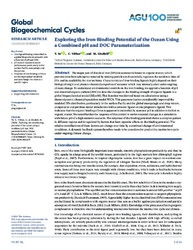Exploring the Iron-Binding Potential of the Ocean Using a Combined pH and DOC Parameterization
DOI: https://doi.org/10.1029/2019GB006425
Persistent URL: http://resolver.sub.uni-goettingen.de/purl?gldocs-11858/9316
Persistent URL: http://resolver.sub.uni-goettingen.de/purl?gldocs-11858/9316
Ye, Y.; Völker, C.; Gledhill, M., 2020: Exploring the Iron-Binding Potential of the Ocean Using a Combined pH and DOC Parameterization. In: Global Biogeochemical Cycles, Band 34, 6, DOI: 10.1029/2019GB006425.
 |
Dokument öffnen: |
The major part of dissolved iron (DFe) in seawater is bound to organic matter, which prevents iron from adsorptive removal by sinking particles and essentially regulates the residence time of DFe and its availability for marine biota. Characteristics of iron-binding ligands highly depend on their biological origin and physico-chemical properties of seawater which may intensely alter under ongoing climate change. To understand environmental controls on the iron binding, we applied a function of pH and dissolved organic carbon (DOC) to describe changes in the binding strength of organic ligands in a global biogeochemical model (REcoM). This function was derived based on calculations using a thermodynamic chemical speciation model NICA. This parameterization considerably improved the modeled DFe distribution, particularly in the surface Pacific and the global mesopelagic and deep waters, compared to our previous model simulations with a constant ligand or one prognostic ligand. This indicates that the organic binding of iron is apparently controlled by seawater pH in addition to its link to organic matter. We tested further the response of this control to environmental changes in a simulation with future pH of a high emission scenario. The response of the binding potential shows a complex pattern in different regions and is regulated by factors that have opposite effects on the binding potential. The relative contributions of these factors can change over time by a continual change of environmental conditions. A dynamic feedback system therefore needs to be considered to predict the marine iron cycle under ongoing climate change.
Statistik:
ZugriffsstatistikSammlung:
This is an open access article under the terms of the Creative Commons Attribution License, which permits use, distribution and reproduction in any medium, provided the original work is properly cited.

